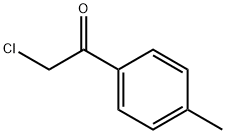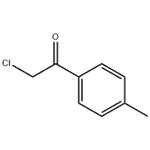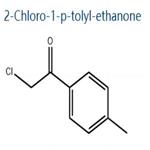2-chloro-1-(4-methylphenyl)ethanone (cas# 4209-24-9) can be used for preparation of acetophenone derivatives, which are known to be fungicides that control phytopathogenic fungi. In addition, this compound can be used for synthesis of clinafloxacin triazole hybrids, which are also known for the their antifungal and antibacterial activity. Moreover, this compound was found to inhibit (uncompetitively to ATP) pyruvate dehydrogenase (PDH), meaning it inhibits further glucose oxidation. That is why this compound can potentially be used to treat such conditions as diabetes and/or ischemia.
To a suspension of anhydrous aluminum chloride (5.60 g, 40 mmol) in anhydrous toluene (40 mL), chloroacetyl chloride (4.52 g, 40 mmol) was slowly added dropwise. After the aluminum chloride had dissolved, the mixture was heated slowly to 80 °C and held at that temperature for 2 h, then cooled and poured into crushed ice (100 g)containing concentrated hydrochloric acid (10 mL). The reaction liquid is extracted by toluene, concentrated, and dried to obtain 2-Chloro-1-p-tolyl-ethanone.
Chloromethyl p-tolyl ketone is a danger compound.
H290 (33.33%): May be corrosive to metals [Warning Corrosive to Metals]
H302 (66.67%): Harmful if swallowed [Warning Acute toxicity, oral]
H314 (33.33%): Causes severe skin burns and eye damage [Danger Skin corrosion/irritation]
H315 (66.67%): Causes skin irritation [Warning Skin corrosion/irritation]
H318 (66.67%): Causes serious eye damage [Danger Serious eye damage/eye irritation]
H319 (33.33%): Causes serious eye irritation [Warning Serious eye damage/eye irritation]
H334 (66.67%): May cause allergy or asthma symptoms or breathing difficulties if inhaled [Danger Sensitization, respiratory]
H335 (66.67%): May cause respiratory irritation [Warning Specific target organ toxicity, single exposure; Respiratory tract irritation]



